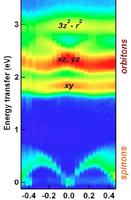 When viewed as an elementary particle, the electron has spin
and charge. When binding to the atomic nucleus, it also acquires an angular
momentum quantum number corresponding to the quantized atomic orbital it
occupies. Even if electrons in solids form bands and delocalize from the
nuclei, in Mott insulators they retain their three fundamental quantum numbers:
spin, charge and orbital. The hallmark of one-dimensional physics is a breaking
up of the elementary electron into its separate degrees of freedom. The
separation of the electron into independent quasi-particles that carry either
spin (spinons) or charge (holons) was first observed fifteen years ago. Here we
report observation of the separation of the orbital degree of freedom (orbiton)
using resonant inelastic X- ray scattering on the one-dimensional Mott
insulator Sr2CuO3. We resolve an orbiton separating itself from spinons and
propagating through the lattice as a distinct quasi-particle with a substantial
dispersion in energy over momentum, of about 0.2 electronvolts, over nearly one
Brillouin zone [1].
When viewed as an elementary particle, the electron has spin
and charge. When binding to the atomic nucleus, it also acquires an angular
momentum quantum number corresponding to the quantized atomic orbital it
occupies. Even if electrons in solids form bands and delocalize from the
nuclei, in Mott insulators they retain their three fundamental quantum numbers:
spin, charge and orbital. The hallmark of one-dimensional physics is a breaking
up of the elementary electron into its separate degrees of freedom. The
separation of the electron into independent quasi-particles that carry either
spin (spinons) or charge (holons) was first observed fifteen years ago. Here we
report observation of the separation of the orbital degree of freedom (orbiton)
using resonant inelastic X- ray scattering on the one-dimensional Mott
insulator Sr2CuO3. We resolve an orbiton separating itself from spinons and
propagating through the lattice as a distinct quasi-particle with a substantial
dispersion in energy over momentum, of about 0.2 electronvolts, over nearly one
Brillouin zone [1].
[1] J. Schlappa, K. Wohlfeld, K. J. Zhou, M. Mourigal, M. W. Haverkort, V. N. Strocov, L. Hozoi, C. Monney, S. Nishimoto, S. Singh, A. Revcolevschi, J.-S. Caux, L. Patthey, H. M. Rønnow, Jeroen van den Brink and T. Schmitt, Nature 485, 82 (2012).

